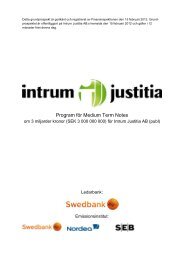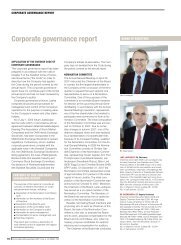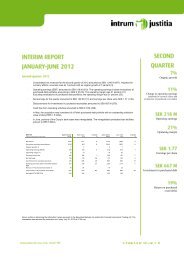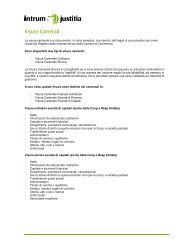ANNUAL REPORT INTRUM JUSTITIA A N N U A L R EP O R T 2 0 ...
ANNUAL REPORT INTRUM JUSTITIA A N N U A L R EP O R T 2 0 ...
ANNUAL REPORT INTRUM JUSTITIA A N N U A L R EP O R T 2 0 ...
You also want an ePaper? Increase the reach of your titles
YUMPU automatically turns print PDFs into web optimized ePapers that Google loves.
54<br />
Notes<br />
and expenses, and unrealized gains and losses that<br />
arise from transactions within the Group are eliminated<br />
in their entirety in the consolidated accounts.<br />
Unrealized gains from transactions with associated<br />
companies and joint ventures are eliminated<br />
to the extent they correspond to the Group’s<br />
ownership interest in the company. Unrealized<br />
losses are eliminated in the same way as unrealized<br />
gains, to the extent there is an indication of<br />
impairment.<br />
Associated companies<br />
The Group applies IAS 28 Investments in Associates.<br />
Associated companies are companies that are<br />
not subsidiaries but where the Parent Company,<br />
directly or indirectly, has at least 20 percent of the<br />
votes or otherwise exercises significant influence<br />
without having control over the partly owned<br />
company.<br />
Participations in associated companies are recognized<br />
in the consolidated accounts according to<br />
the equity method, which means that the holding<br />
in the associated company is recognized at cost<br />
and subsequently adjusted to the Group’s share of<br />
the change in the associated company’s net assets.<br />
The value of the shares includes goodwill from<br />
the acquisition. The consolidated income statement<br />
includes the Group’s profit participation less<br />
goodwill impairment. The amount is recognized<br />
on the line, Participations in associated companies.<br />
Dividends received from the associated company<br />
are not recognized through profit or loss and instead<br />
reduce the carrying value of the investment.<br />
Any difference between the cost of an acquisition<br />
and the owner’s share of the net fair value of<br />
the associated company’s identifiable assets, liabilities<br />
and contingent liabilities is recognized in accordance<br />
with IFRS 3.<br />
The equity method is applied from the date a<br />
significant influence arises until the time it ceases<br />
or the associated company becomes a subsidiary.<br />
If the Group’s share of reported losses in the associated<br />
company exceeds the carrying value of its<br />
participations, the value of those participations is<br />
reduced to nil. Losses can also be offset against the<br />
Group’s unsecured receivables from the associated<br />
company if they constitute part of the net investment.<br />
Further losses are not recognized provided<br />
the Group has not issued guarantees to cover them.<br />
Joint ventures<br />
The Group applies IAS 31 Investments in Joint<br />
Ventures.<br />
Joint ventures pertain to companies in which<br />
Intrum Justitia and other part-owners manage<br />
operations jointly in accordance with a shareholder<br />
agreement. The Group’s joint ventures all<br />
constitute legal entities, which are reported in the<br />
consolidated financial reports in accordance with<br />
the proportional method. This means that Intrum<br />
Justitia’s share of assets, liabilities, revenues<br />
and expenses in the jointly owned company is<br />
consolidated, item for item, with corresponding<br />
items in the consolidated income statement and<br />
balance sheet.<br />
Only equity earned subsequent to acquisition<br />
is recognized in the Group’s equity. The proportional<br />
method is applied from the date when<br />
shared control is obtained until the date it ceases.<br />
foreign currency<br />
The Group applies IAS 21 Effects of Changes in<br />
Foreign Exchange Rates.<br />
Transactions in foreign currency<br />
Group companies prepare their accounts in the<br />
local functional currency in the country where<br />
they have their operations. Transactions in a<br />
currency other than the local currency are recognized<br />
at the exchange rate in effect on the transaction<br />
day. When such transactions are offset or<br />
settled, the exchange rate may deviate from the<br />
one that applied on the transaction day, in which<br />
case a (realized) exchange rate difference arises.<br />
Moreover, monetary assets and liabilities in foreign<br />
currency are translated at the exchange rates<br />
on each balance sheet date, due to which an (unrealized)<br />
exchange rate difference arises. Both realized<br />
and unrealized exchange rate differences<br />
of this type are recognized through profit or<br />
loss – in operating earnings if, for example, they<br />
refer to accounts receivable or accounts payable,<br />
or in net financial items if they refer to financial<br />
investments and borrowing in foreign currency.<br />
To avoid exchange rate differences, receivables<br />
and liabilities in foreign currency are sometimes<br />
hedged through forward exchange contracts.<br />
The Group’s holding of forward exchange<br />
contracts is marked to market on each balance<br />
sheet date, and changes in value are recognized<br />
through profit or loss.<br />
Translation of the financial<br />
statements of foreign operations<br />
Assets and liabilities in foreign operations, including<br />
goodwill and other Group surplus and deficit<br />
values, are translated from the functional currency<br />
to the Group’s reporting currency, Swedish kronor,<br />
at the exchange rate on balance sheet date. Revenue<br />
and expenses are translated at the average<br />
rate, which serves as an approximation of the rate<br />
that applied on each transaction date. Translation<br />
differences arise in the translation of subsidiary<br />
accounts in part because the balance sheet date<br />
rate changes each period and in part because the<br />
average rate deviates from balance sheet date rate.<br />
Translation differences are recognized directly in<br />
total comprehensive income as the year’s change<br />
in the translation reserve.<br />
Long-term receivables and liabilities between<br />
the Parent Company and subsidiaries can be seen<br />
as an extension or reduction of the net investment<br />
in each company. Such translation differences are<br />
therefore recognized in the consolidated financial<br />
statements in total comprehensive income.<br />
When foreign operations are sold, accumulated<br />
translation differences attributable to those operations<br />
are realized.<br />
The company has zeroed accumulated translation<br />
differences attributable to the period prior to<br />
January 1, 2004, the date of transition to IFRS.<br />
During the year the Group did not hedge any other<br />
flow exposure pertaining to anticipated receipts or<br />
disbursements in foreign currency.<br />
financial assets and liabilities<br />
The Group applies IAS 39 Financial Instruments:<br />
Recognition and Measurement.<br />
A financial instrument is defined as any form of<br />
agreement giving rise to a financial asset in a com-<br />
pany and a financial liability or equity instrument<br />
in a counterparty.<br />
Financial instruments recognized in the balance<br />
sheet include, on the asset side, cash and bank balances,<br />
accounts receivable and other equity instruments,<br />
loans receivable, purchased debt and derivatives.<br />
Client funds are recognized on a separate line<br />
in the balance sheet and therefore are not included<br />
in the Group’s reported liquid assets. Included<br />
among liabilities and equity are accounts payable,<br />
client funds payable, debt and equity instruments<br />
in issue, loan liabilities and derivatives.<br />
Financial instruments are initially recognized<br />
at cost, corresponding to the instrument’s fair<br />
value plus transaction expenses. An exception is<br />
made for financial instruments in the category<br />
financial assets, which are recognized at fair value<br />
through profit or loss. They are recognized at fair<br />
value excluding transaction expenses. Subsequent<br />
measurement depends on how they are classified,<br />
as indicated below.<br />
A financial asset or financial liability is recognized<br />
in the balance sheet when the company becomes<br />
party to the instrument’s contractual terms.<br />
Accounts receivable are recognized in the balance<br />
sheet when an invoice has been sent. Liabilities are<br />
recognized when the counterparty has performed<br />
and there is a contractual obligation to pay, even<br />
if an invoice has not yet been received. Trade accounts<br />
payable are recognized when an invoice is<br />
received.<br />
A financial asset is removed from the balance<br />
sheet when the rights in the agreement are realized,<br />
expire or the company loses control over them.<br />
A financial liability is removed from the balance<br />
sheet when the obligation in the agreement has<br />
been discharged or otherwise extinguished.<br />
The fair value of listed financial assets corresponds<br />
to their listed market price on the balance<br />
sheet date. The fair value of unlisted financial assets<br />
is determined by using valuation techniques,<br />
e.g., recently conducted transactions, the price<br />
of similar instruments and discounted cash flows.<br />
For further information, see Note 37.<br />
Long-term receivables and other receivables<br />
Long-term receivables and other current receivables<br />
are receivables that arise when the company<br />
provides money without the intent to trade its<br />
claim. If the anticipated maturity is longer than<br />
one year they constitute long-term receivables,<br />
and if it is shorter they are other receivables.<br />
These receivables fall into the category Loans<br />
and receivables.<br />
Accounts receivable<br />
Accounts receivable are classified in the category<br />
loans and receivables. Accounts receivable are<br />
recognized at the amount expected to be received<br />
after deducting impaired receivables, which are<br />
determined individually or according to statistical<br />
models based on historical experience in each<br />
country. The need to write-down receivables will<br />
be taken into account when a certain number of<br />
days have passed since they fell due. The number<br />
will vary from country to country. Provisions for<br />
impaired receivables are recognized as sales and<br />
marketing expenses. The anticipated maturity of<br />
accounts receivable is short, so they are carried at<br />
nominal amount without discounting.
















